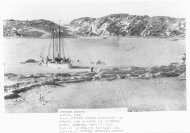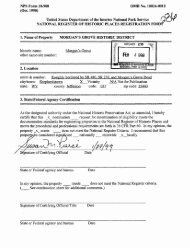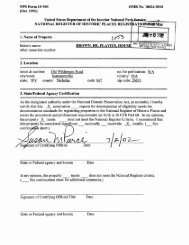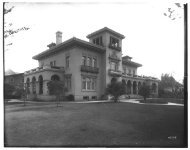Nomination form - National Park Service
Nomination form - National Park Service
Nomination form - National Park Service
Create successful ePaper yourself
Turn your PDF publications into a flip-book with our unique Google optimized e-Paper software.
DESCRIPTION<br />
CONDITION<br />
CHECK ONE<br />
CHECK ONE<br />
—EXCELLENT<br />
—DETERIORATED<br />
—UNALTERED<br />
.XoRIGINALSITE<br />
X-GOOD<br />
—RUINS<br />
.X.ALTERED<br />
—MOVED<br />
DATE.<br />
_FAIR<br />
—UNEXPOSED<br />
DESCRIBE THE PRESENT AND ORIGINAL (IF KNOWN) PHYSICAL APPEARANCE<br />
Ellensburg, population 13,700, is located in the Kittitas Valley along the east slope of<br />
the Cascade Mountains near the geographic center of Washington State. It is a crossroads<br />
community at the junction of Interstate Highways 82 and 90, on U. S. Highway 97 and State<br />
Highways 10 and 131. The valley is a prosperous agricultural and stock raising district<br />
surrounded on four sides by mountain ranges that diminish to the southeast. Meandering<br />
down from the Cascades across the valley floor, the Yakima River is the basin's principal<br />
drainage with a system of branching creeks that join it from all directions. The land area<br />
immediately surrounding Ellensburg has a rolling or gently sloping topography, but the<br />
town site itself is quite flat.<br />
The climate is considered semi-arid, although large scale irrigation of the bottom land<br />
produces good yields of hay, alfalfa, wheat, oats, barley, potatoes, peas and apples.<br />
Crops such as hay and alfalfa require comparatively Tittle irrigation and the natural<br />
grassy ground cover makes the uncultivated acreage most suitable for grazing. Beef cattle<br />
are the major agricultural enterprise in the county accounting for roughly 80% of all farm<br />
income. Annual precipitation is less than nine inches and the sky is generally clear or<br />
partly cloudy from April until October.<br />
Ellensburg encompasses approximately 2,500 acres of land, or nearly four square miles.<br />
Forty percent of this land is developed in residential neighborhoods. Street rights-of-way<br />
occupy an additional twenty percent. Central Washington State College has a generous<br />
170 acre campus located immediately northeast of the central business district and within<br />
the city itself.<br />
Downtown Ellensburg is an area encompassing about 16 square blocks, a major portion of which<br />
is the 20 acre historic district. The buildings are predominantly one or two story brick<br />
commercial structures with shop fronts and taverns at the street level and rooms or office<br />
space above. With few exceptions these buildings were constructed between 1889 and 1917.<br />
Slightly less than half of the surviving structures were planned and completed within a<br />
single year when Ellervsburg hurriedly rebuilt following a fire on July 4, 1889 that consumed<br />
10 blocks of the city's downtown. The remainder were added later over a period of<br />
years after nearly a decade of inactivity brought on by a serious economic depression that<br />
put an end to plans for further expansion. The recovery began in 1897, although none of<br />
the more recent buildings pre-dates 1900.<br />
•<br />
The primary and secondary historic structures of the district typify modest scale commercial<br />
building in the American West between 1889 and 1930. A definite stylistic categorization ;<br />
would be somewhat misleading for most of Ellensburg's buildings in that they represent the ;<br />
work of local carpenter-builders untrained in architecture who have introduced personal<br />
variations that do not con<strong>form</strong> to any particular style. A few buildings like the Cadwell<br />
Block, which is also known as the "Horseshoe Block", show remarkable freedom in their<br />
unconventional fenestration and cornice work giving a unique "Western" quality to the design<br />
Generally, the earlier structures are Italianate in spirit with hooded arches, complex<br />
pilasters, a wide decorative frieze (either 'sheet 1 metal or corbelled brick) overscaled<br />
brackets and a projecting cornice. The cornice is often interrupted by a false gable<br />
inscribed with the name of the building and its date of construction.<br />
After the depression, a more anonymous architectural treatment was generally used that<br />
might be classified Commercial Style except for the small scale. Structural openings are ;<br />
either flat arched or lintelled, although segmental and semicircular arches persist on<br />
some upper stories. The use of decorative brickwork is very restricted with little relief
















